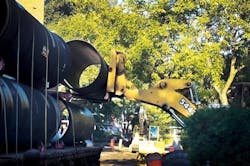How To: Sewer Maintenance: Pipe Down
The cost is enormous: Over the next two decades, the U.S. must spend more than $300 billion to repair and replace wastewater and storm water systems. Pipe constitutes about 75% of this total expenditure, according to a report by the American Society of Civil Engineers—a whopping $225 billion.
To cite one typical example, one large East Coast city reports 60% of its more than 3,000 miles of sewer line may have served beyond the expected service life. The U.S. has almost 800,000 miles of public sewer main, much of which may be in need of renewal. Some have been in service for many decades, some have served up to and beyond expected service lives, and some possess designs, such as combined sanitary/storm sewer pipelines, that are now outdated. Renewals are expensive undertakings, but when completed, should result in systems that are more sustainable for future generations.
When deciding how to replace or repair sewer lines, one of the fundamental decisions these municipalities must make is the kind of pipe to be used. Municipal officials and engineering departments are concerned about longevity, durability and failure rates. The choice must be made in the context of overall systems, their construction, and their performance over their lifetimes to include both upfront and ongoing costs.
Three Considerations
There are three primary considerations for a sanitary sewer pipeline. First, the pipe should be strong, with bottle-tight joints that keep groundwater and storm water from intruding into the sanitary sewer system. Wastewater treatment plants are expensive, and treating waters that are not truly the sewage they were designed to treat is wasteful. Second, the pipe should be reliable. Sometimes sanitary sewage wastewater can become aggressive, so the pipe should be capable of carrying aggressive water without damage to the pipe. Finally, the pipe must be strong enough to carry the heavy external loads that gravity sewer main can experience.
The nature of sanitary sewer pipeline systems means that wastewater may come from residential, commercial, industrial and other sources. Depending on the source, some pretreatment may be required—for example, for industrial sources—before being released into the public collection systems. However, this also results in variability in the nature of wastewater. In addition, if the sewage becomes septic due to loss of dissolved oxygen, it also may become aggressive.
Because sewer lines primarily utilize gravity flow, sewer pipe often is buried deeper than water main and other utilities because of the need to hold line and grade, increasing the earth load on the pipe. As the external load for the pipeline increases, so, too, does the need to provide adequate backfill support. Without this support, the pipe may warp into an oval shape or, worse, collapse. In order to ensure sufficient support, the backfill around the pipe should consist of properly selected materials that are sufficiently compacted to provide the added support the pipeline requires. If the external loads are great enough, select material such as sand or crushed stone must be imported and placed around the pipe and compacted to levels as high as 95% of the ultimate “Proctor” soil density.
While these practices are possible, the more the pipeline relies on sidefill soil support, the more sensitive the pipeline is to proper backfill installation. If a weaker material is designed to receive a 12-in. envelope of highly compacted select material in order to support the external load, it must have that support when it is installed.
A popular reference for the sidefill soil support offered by the surrounding backfill is the Modulus of Soil Reaction, which is designated as E’ (E-prime). With units in pounds per square inch, it is an empirical value that is derived from the type of soil used and the amount of compaction provided.
One measure of testing the installation of a gravity sewer pipeline is the use of a spherical mandrel that is pulled through the installed pipeline to ensure the pipe has not become oval shaped due to excessive deflection from the external loads.
As the industry moves forward on the steps necessary to bring water and wastewater infrastructure to a sustainable state, it should take advantage of the advances made in engineering and manufacturing improvements since that infrastructure was first installed. We can turn that knowledge into a system we can rely upon with confidence.
Download: Here
